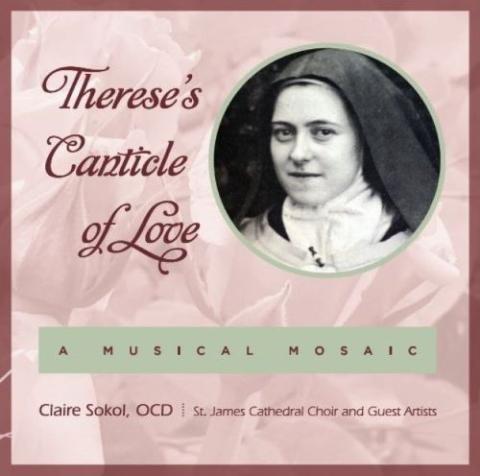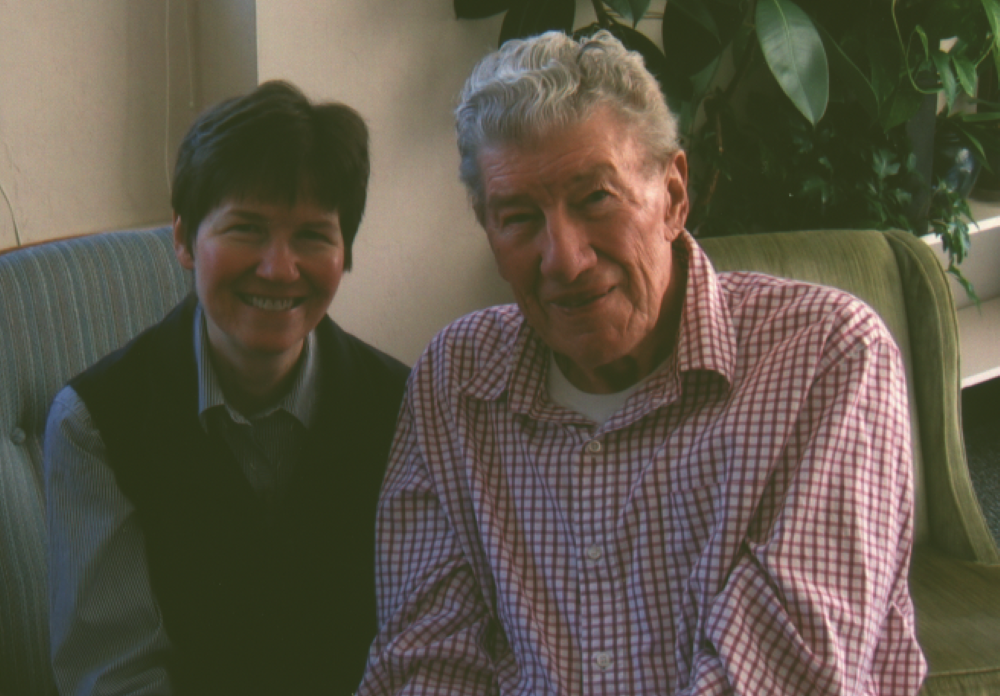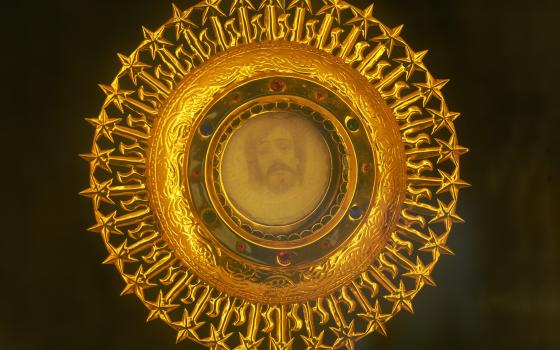Sr. Claire Sokol, a member of the Order of Discalced Carmelites, sits with her composing equipment that she used to score the film "Thérèse: The Story of a Soul." (Claire Sokol)
Few cloistered nuns have sat in a movie theater and heard their own music pouring out of the speakers.
But that's just what Sr. Claire Sokol experienced in 2001 after composing the score for the theatrical film "Thérèse: The Story of a Soul," chronicling the life of French Carmelite St. Thérèse of Lisieux.
"It was really unreal to hear my music blasting through the theater," said Sokol, 69, a member of the Order of Discalced Carmelites. "It was a thrill."
This achievement was a lifetime in the making — and Sokol believes St. Thérèse led her there directly.
A native of Seattle and the seventh of 10 children, Sokol trained musically from childhood, leading to a thriving career as an orchestral and chamber musician. Even after withdrawing into cloistered life at the Carmelite Monastery of Seattle in 1982, later joining Carmel of Reno in Nevada in 2001, Sokol took on significant projects bridging music and faith.
"Music takes people out of themselves, but also takes them deeply within themselves and connects them ultimately with God, however they might define God," she explained.
The impact of her musical work resonates far outside the monastery walls.
When Sokol composed a hymn honoring the 100th anniversary of St. Thérèse's death, "Therese's Canticle of Love," the piece garnered over 34,000 views on YouTube.
" 'Therese's Canticle of Love' was born out of a dark time of depression in my life," Sokol said, noting that she only attempted composing when her plans to commission the hymn fell through. "I attribute the birth of this piece, the healing it brought me, and the discovery of a gift for composing to Thérèse, since she was the one who tricked me into writing the 'Canticle' for her."

Sr. Claire Sokol composed the hymn "Therese's Canticle of Love" to honor the 100th anniversary of St. Thérèse's death. (Claire Sokol)
This success led production company Saint Luke Productions to tap Sokol to compose music for a one-woman play about St. Thérèse. She then scored the company's ensuing film, which flung her into the challenges of learning new technology and engaging with society after 15 years in the cloister.
Sokol even extended her musical reach worldwide, organizing Carmelites across 23 countries for a virtual choir celebrating the 500th birthday of Carmelite nun St. Teresa of Ávila, which earned over half a million views online.
"Creativity is a natural outflow of the contemplative life," Sokol said. "Out of the silence of prayer, art, music, poetry and reflections naturally find expression. One deepens the other."
GSR: How did your family and childhood shape your passion for music?
Sokol: My father conducted the Seattle Youth Symphony. He was a violinist and violist, and a professor of music at the University of Washington. All of my siblings took up string instruments. I took up cello, after beginning with piano.
Our lives centered around our Catholic faith and music. Some of us began our musical training with the Sisters of the Holy Names of Jesus and Mary, who were also our educators.
What did your musical career entail?
After graduating with a bachelor's of music degree from Indiana University, where I studied with János Starker, one the world's greatest cellists at the time, I went on to play in the Omaha, Winnipeg and Vancouver, British Columbia, orchestras.
What led you to becoming a sister?
Even though I was playing in better and better orchestras, with better pay and benefits, something was missing in music as a career for me. From the time I was very young, I had always felt I would be a nun one day.
When I was finishing up my degree at Indiana University, I approached a sister who was studying organ at the school to ask about religious life. She shared with me about her community, and I thought, "That's not it." But when I went to the Carmelite monastery in Seattle for the first time, after having pursued a career for several years, I had the overwhelming sense of having come home. It chose me.
What inspired you to compose the canticle for St. Thérèse, and how did you approach it?
At the time of the 100th anniversary of St. Thérèse's death, the Carmelites in the U.S. talked about what contribution we could make to the celebration. I suggested we commission a well-known composer of liturgical music to write a hymn that the sisters could sing in their communities. I wrote to the composer through his publisher. When a response never came, I said, "Oh well, I'll give it a try." I had a great love for St. Thérèse since the time I entered Carmel 15 years earlier, and I thought it would be nice to do something for her in return for her friendship and guidance.
Once I began, the music flowed from pencil to paper quite easily. It was the lyrics that were a nightmare for me. So, I sought the help of the prioress, Sr. Michael Marie, and together we put words to the piece based on our mutual understanding and love for Thérèse's spirituality.
I never heard the piece until the day it was recorded in St. James Cathedral, Seattle. I walked into the recording session knowing this could be the most embarrassing day of my life. To my utter amazement, "Therese's Canticle of Love" was beautiful.

Sr. Claire Sokol and her father, Vilem Sokol, worked together to compose the music for the film "Thérèse: The Story of a Soul." (Claire Sokol)
Can you discuss the challenges of scoring the film "Thérèse"?
I agreed to take on this project after discerning with my community, who also supported my request to take a one-month summer course to learn the music software program Finale. I went to school knowing I had only one month to produce a score for the "Thérèse" movie following the course.
It was a very intense time. I spent all morning in class, then returned to the monastery, my mind still dizzy from the class, never really knowing if I was capable of producing a movie score or not.
Since the movie was being filmed at the same time I was composing the score, I had nothing to go on in terms of how long the scenes were, or even how many scenes there were.
The daily life of the community went on, such as rising early, prayer with community throughout the day and private prayer. But in the midst of all that, there were emails and phone calls and working on the computer, and I may have even been prioress at the time.
It was really an awful lot, which is why I did a lot of the (composing) work at night, which meant I didn't get much sleep.
What helped you overcome these challenges?
I asked my father for help. He composed the scene where Thérèse was experiencing the "dark night" (during her battle with tuberculosis).
Composing was new for him as well, and he ended up being really good at it. He would bring me his handwritten manuscript, and I would put it into Finale so that I could easily generate parts for all the instruments. He advised me on other scenes, and encouraged me when I was ready to give up. It was a wonderful experience working alongside not only my father, but a great musician.
What led you to create a virtual choir of Carmelite nuns?
I composed (musical piece) "Nada te Turbe" in anticipation of the 500th anniversary of the birth of St. Teresa of Avila. It premiered at a celebration for St. Teresa in San Jose, California, in 2014. I floated the idea of a virtual choir of Carmelite nuns to the planning committee I was serving on for that event, fully expecting them to debunk the idea. They didn't.
Teresa's prayer, "Nada te Turbe (Let Nothing Disturb You)" was the natural choice of text, since every Carmelite worldwide knew the prayer in Spanish. Composing the music was the easy part. Organizing the virtual choir was not. It was an enormous undertaking!
What was involved with organizing the virtual choir?
I was able to track down Scott Haines, who produced (composer) Eric Whitacre's original virtual choir, and received a commitment from him to do our project.
Scott quickly put together a website where the nuns could download a copy of the music, learn it with the help of a practice track while watching the conductor, and then submit their recording through the website.
Meanwhile, I was able to secure a letter of support from the superior general of the Carmelite Order, which we then had translated into several languages, and emailed it to associations of nuns all over the world with an explanation of the project and an invitation to participate in the choir via a website link.
We had no idea what sort of response we would get. It was thrilling when we started receiving responses from the Netherlands, Canada, China, France, etc.
Eventually, over 100 sisters joined from 23 countries. What a tribute to Teresa from all her sisters!
Advertisement
How does it feel to impact others through your music?
Occasionally, I hear from people who share very touching things about the impact of my music. A gentleman wrote me recently who has a son with Down syndrome. He plays "Therese's Canticle of Love" for him every night to help put him to sleep. That touches me very deeply.
Generally, though, I'm not really aware of the impact my music has had. It's not something I dwell on. I give what has been given to me, and let God do the rest.





